“What is a wave in physics?” To master the idea of waves, you need to understand the different types of waves as well.
Table of Contents
Introduction
Waves, once considered mysterious, are now understood as one of the most important concepts in physics and engineering. They shape the world around us, appearing in sound, light, water, and countless technologies.
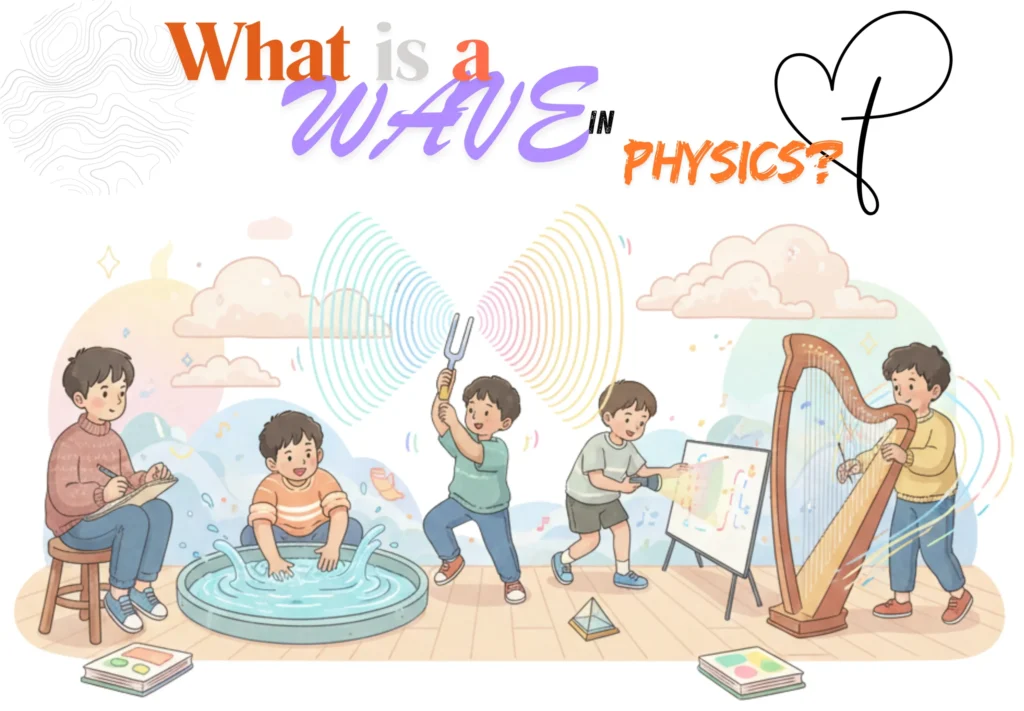
A wave is not the movement of matter itself, but a way of transferring energy and information. For example, when you throw a stone into a pond, ripples spread outward, but the water itself does not travel across the pond. They serve as a core concept in physics and engineering.
This guide is designed for middle and high school students. By the end, you should have a solid understanding of:
- What waves are?
- How are they classified?
- Why do they matter in science and everyday life?
What is a Wave?
A wave can be defined as:
“A disturbance that moves from place to place, carrying energy and information”.
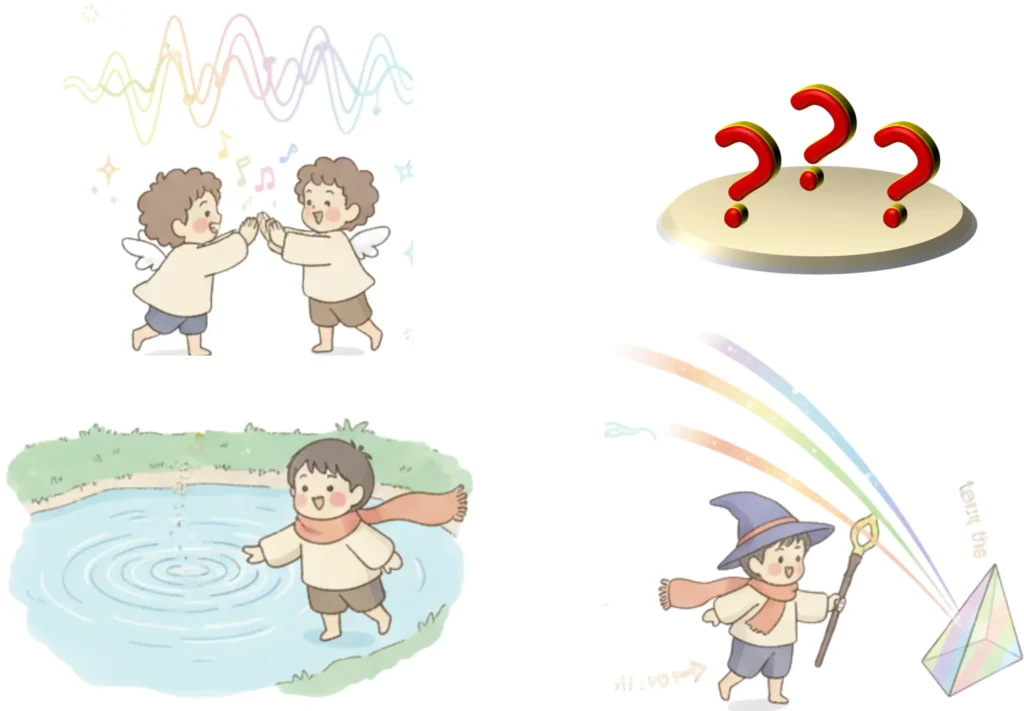
Examples
- Dropping a pebble in still water.
- Speaking to the audience in a big hall.
- Switching on a light or electronic devices.
Each example shows energy being transmitted through a repeating pattern or pulse.
Key Takeaways
- Waves are organised oscillations.
- They act as carriers of energy (and not the matter).
- They often repeat in time as pulses or continuous patterns.
Types of Waves
Waves can be classified in different ways. The 3 most common criteria for the classification of waves are:
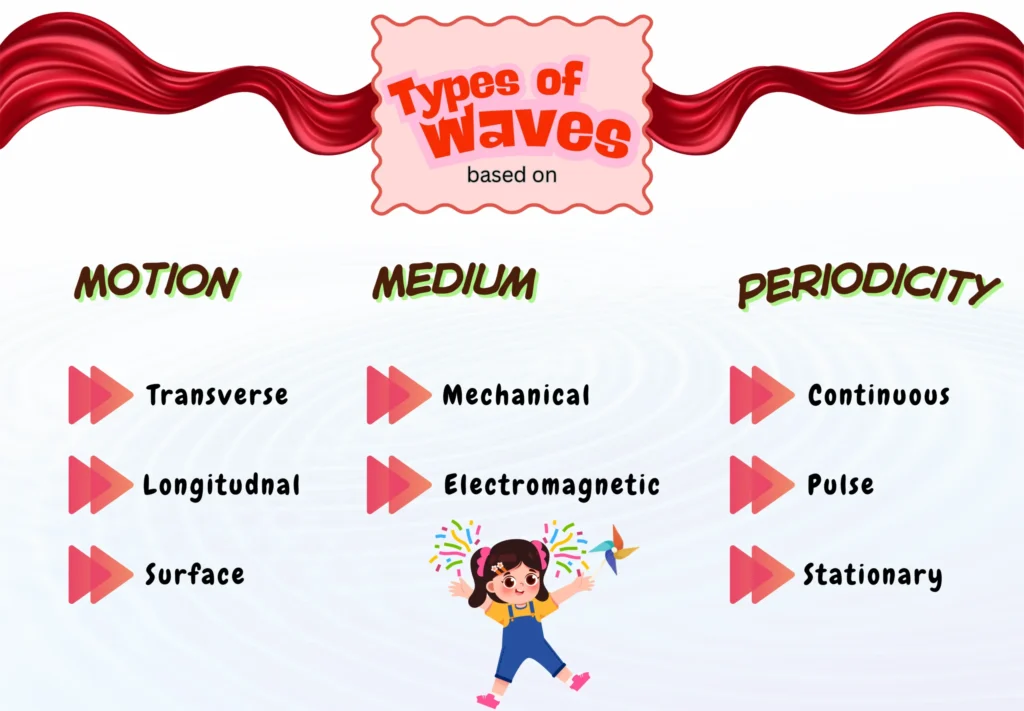
1. Based on the Medium Required
Some waves travel in the presence of a material (matter) while others do not need a material at all. This divide is very useful in science and technology.
Mechanical Waves
Need a Medium
Mechanical waves travel from one place to another only through a medium.
Mechanical waves move by pushing and pulling the particles of the medium. Without a medium, these waves cannot travel. The media they require can be any state of matter, like solid, liquid, or gas.
Example
- Sound in the air
- Ripples on water

Electromagnetic waves
No Medium Needed
Electromagnetic waves can travel through space (a vacuum), unlike mechanical waves that require matter.
EM waves consist of oscillating electric and magnetic fields. These fields are at right angles to each other as well as perpendicular to the direction of wave travel. James Clerk Maxwell proved that electromagnetic waves move at the speed of light.
The discovery of EMW became the foundation of modern physics and communication technology.
Example
- Radio Waves
- Visible Light
- X-rays

2. Based on the Direction of Particle Motion
Mechanical waves are often sorted by how the particles move as the wave passes. This sorting helps to analyse effects like polarisation and sound behaviour.
Transverse Waves
Up and Down Motion
Transverse waves are the waves in which particles move perpendicular to the wave direction. These waves can show the effect of polarisation.
Example
- A Plucked Guitar String
- Visible Light (in classical terms)

Longitudinal Waves
Left and Right Motion
In longitudinal waves, particles move along the same line as the wave. The particles in the medium undergo compression and rarefaction as the wave moves.
Example
- Compression Waves in a Spring
- Sound Waves in a Medium
Surface Waves
Mixed Motion
A surface wave happens at the boundary between two materials (e.g., air meets water). It is a mix of two motions:
- Up-and-down (like a transverse wave)
- Back-and-forth (like a longitudinal wave)
When these motions combine, the particles move in circles or loops.
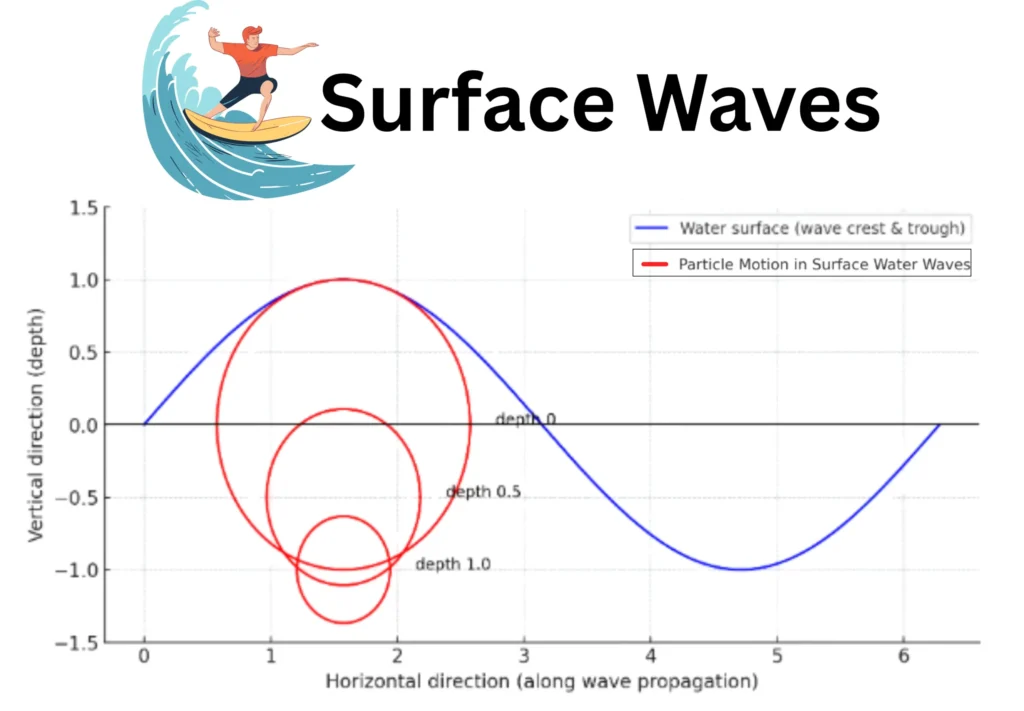
Example
- The ocean water does not move across the sea with the wave. Instead, each drop of water moves in a circle, and the wave pattern travels forward.
- During an earthquake, special surface waves travel along the ground. They make the surface of the Earth shake strongly, which can damage buildings.
3. Based on Energy Transmission
Waves can also be classified according to how they transmit energy over time, a property known as periodicity. Understanding periodicity makes it easier to study phenomena such as sound pulses, music, and radio signals.
Periodic Waves
Continuous Transmission
Periodic waves repeat their pattern over time. Periodic waves are the basis of many instruments and signal systems.
Example
A steady musical note is an example.
Note: Unlike other waves, you can measure the frequency and wavelength of periodic (or continuous) waves easily.
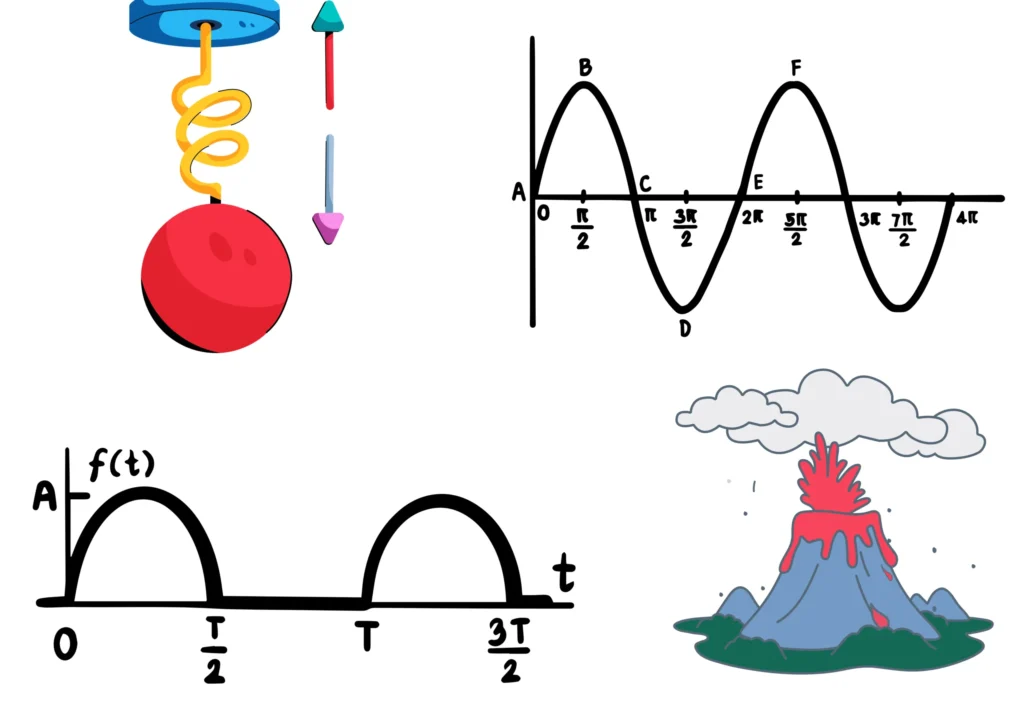
Pulse Waves
Intermittent Transmission
A pulse is a single and discontinuous short disturbance. They can be used to test systems or send short signals.
Example
Dropping one stone into water creates a pulse.
Note: Pulse waves are easier to analyse in time than continuous waves. Moreover, both periodic waves and pulse waves are also known as progressive (or travelling) waves.
Standing Waves
Still Configuration
A standing wave, also known as a stationary wave, is a wave pattern formed by two identical waves. The waves move in opposite directions, which interfere with each other.

Example
Musicians use standing waves to shape musical notes.
Note:
- Standing waves form when a forward wave and its reflected (backward) wave interfere.
- This interference creates nodes (no displacement) and antinodes (maximum displacement).
- They occur only at specific harmonic frequencies (fundamental, 2nd harmonic, 3rd harmonic, etc.).
- Standing waves look like a fixed pattern because the energy is trapped within the medium (like a guitar string or air column in a pipe).
The Science and Engineering of Waves
Scientists use instruments like oscilloscopes for electrical waves. They use seismographs for earthquakes. They also use hydrophones to record underwater sound. Each tool converts the wave into a readable record.
Engineers put the understanding of the idea of waves into action, designing buildings to resist seismic waves. They shape concert halls to control sound waves. They design antennas that send and receive radio waves.
Wave knowledge helps to innovate the technology and make reliable systems in many fields. Accurate design needs both maths and hands-on testing in a laboratory.
Application of Waves in Real Life
All modern technologies depend on wave control and materials. Each of these systems depends on knowing how waves behave and lose energy.
1. Communication & Optics
- Cameras and microscopes use light waves to form images.
- Radio, TV, and Wi-Fi use electromagnetic waves to carry data.
- Fibre-optic cables send light through glass to move huge amounts of information.
2. Medicine & Imaging
- Doctors use sound and electromagnetic waves for diagnosis.
- Medical sources explain how sound reflections build pictures.
- Ultrasound uses high-frequency sound to make images of the body. It is safe and non-ionising, so it is widely used.
3. Earth, Ocean, & Structure Science
- Engineers study wave loads to design coastal defences.
- Seismology uses waves to map the inner layers of the Earth.
- Seismic waves tell us how earthquakes spread and what lies under the surface of the Earth.
- Ocean waves move energy that can be harnessed for power generation as a renewable energy source.
4. Everyday Tech & Safety
- Radar finds objects using reflected radio waves.
- Microwaves heat food by exciting water molecules.
- Noise control in buildings relies on wave absorption and insulation.
Quick Experiments Students Can Try (Safe, Simple)
These simple hands-on tests make the ideas clear.
- Make a wave on a rope by flicking one end.
- Make standing waves on a string with a tuning fork.
- Use a slinky to show compression waves and transverse waves.
Common Misunderstandings & Clarifications
- Waves do not move matter across long distances in most cases. Only the disturbance moves in the form of energy and/or information.
- Sound is a longitudinal, mechanical wave that requires a medium. In contrast, light is a transverse, electromagnetic wave that does not need a medium.
- Standing waves do not travel, though they store energy in the medium.
Clearing these points helps avoid mixing up ideas.
Conclusion
Waves are a simple idea with wide power. They let energy and information move without the flow of the substance. From medicine to music, waves shape modern life. If you practice small experiments and use the relations here, waves will start to feel obvious and useful.
Frequently Asked Questions
What is a wave in physics?
A wave is a disturbance that moves from place to place, carrying energy and information, without transporting matter itself.
What are the main types of waves?
Waves are mainly classified as mechanical (need a medium) and electromagnetic (travel without a medium). They can also be transverse, longitudinal, surface, periodic, pulse, or standing waves based on motion and energy transmission.
What is a mechanical wave?
A mechanical wave requires a medium, such as air, water, or solids, to travel. Examples include sound waves in air and ripples on water.
What is an electromagnetic wave?
Electromagnetic waves can travel through a vacuum without any medium. They consist of oscillating electric and magnetic fields. Examples include light, radio waves, and X-rays.
What is the difference between transverse and longitudinal waves?
- Transverse Waves: particles move perpendicular to the wave direction (e.g., a plucked guitar string).
- Longitudinal Waves: particles move along the wave direction (e.g., sound in air).
What are surface waves?
Surface waves occur at the boundary between two materials, combining transverse and longitudinal motion. Ocean waves and certain earthquake waves are examples.
What is a pulse wave?
A pulse wave is a single, short disturbance that travels through a medium. Dropping a stone in water creates a pulse wave.
What is a standing wave?
A standing wave is formed when two identical waves travel in opposite directions, creating nodes (no motion) and antinodes (maximum motion). Examples are guitar strings and air columns in pipes.
How are waves used in everyday technology?
Waves power communications (radio, Wi-Fi), imaging (ultrasound, cameras), and household technologies (microwave ovens, noise control).
Why are waves important in science and engineering?
Understanding waves allows engineers and scientists to design buildings, antennas, coastal defences, and medical imaging tools, making technology safer and more efficient.

